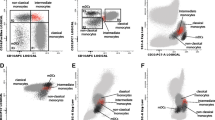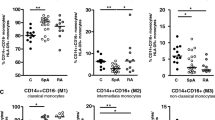Abstract
The objective of this study was to investigate the expressions of toll-like receptors on neutrophils and monocytes in Behcet’s disease (BD). Forty-two patients with BD were included in the study. Baseline and stimulated cells with heat shock protein-60 (HSP-60), lipopolysaccharide (LPS) and crude extract of Streptococcus sanguis (SS) were analyzed for toll-like receptor-1, -2, -4 and -6 expressions using flow cytometer. Results were confirmed using semi-quantitative PCR technique. The mean frequency of TLR-6 expressing granulocytes in BD patients was significantly lower than in controls (4.2 ± 0.6 vs. 9.2 ± 0.6 and 8.0 ± 1.4, BD vs. rheumatoid arthritis (RA) and healthy control (HC); P < 0.05). TLR-6 expressing granulocyte population was enhanced after stimulation with HSP-60 and SS (20 ± 0.5 and 12.8 ± 0.6, respectively). Decreased TLR-2 expression was noted in monocytes of BD patients after stimulation with HSP-60 and LPS (71.0 ± 0.5 and 73.0 ± 0.5; P < 0.02, for both antigens). Functional abnormalities of these receptors or different activation cascades by different microorganisms are associated with disease pathogenesis in Behcet’s disease.



Similar content being viewed by others
References
Yazici H, Yurdakul S, Hamuryudan V (1998) Behcet’s syndrome. In: Klippel JH, Dieppe PA (eds) Rheumatology. Mosby, London, 7:26:1–6
Mumcu G, Inanc N, Yavuz S, Direskeneli H (2007). The role of infectious agents in the pathogenesis, clinical manifestations and treatment strategies in Behcet’s disease. Clin Exp Rheumatol, Sept. 2007 Supplement
Lehner T, Lavery E, Smith R et al (1991) Association between the 65 kDa heat shock protein, Streptoccocus sanguis and the corresponding antibodies in Behcet’s syndrome. Infect Immun 59:1434–1441
Mumcu G, Ergun T, Inanc N et al (2004) Oral health is impaired in Behcet’s disease and associated with disease severity. Rheumatology 43:1028–1033
Direskeneli H, Eksioglu-Demiralp E, Yavuz S, Ergun T, Lehner T, Akoglu T (2000) T cell responses to 60/65 kDa HSP derived peptides in Turkish Behcet’s disease patients. J Rheum 27:708–713
Miura T, Ishihara K, Kato T et al (2005) Detection of heat shock proteins but not superantigen by isolated oral bacteria from patients with Behcet’s disease. Oral Microbial Immunol 20:167–171
Kol A, Lichtman AH, Finberg RW, Libby P, Kurt-Jones EA (2000) Heat shock protein 60 activates the innate immune response: CD14 is an essential receptor for HSP-60 activation of mononuclear cells. J Immunol 164:13–17
Chen W, Syldath U, Bellman K, Burkart V, Kolb H (1999) Human 60-kDa Heat shock protein: a danger signal to the innate immune system. J Immunol 162:3212–3219
Takeda K, Kaisho T, Akira S (2003) Toll-like receptors. Annu Rev Immunol 21:335–376
Henneke P, Morath S, Uematsu S et al (2005) Role of lipoteichoic acid in the phagocyte response to group B streptococcus. J Immunol 174:6449–6455
Takeuchi O, Kawai T, Muhiracht PF et al (2001) Discrimination of bacterial lipoproteins by toll-like receptor 6. Int Immunol 13:933–940
International study group for Behcet’s disease (1990) Criteria for diagnosis of Behcet’s disease. Lancet 335:1078–1080
Nakao Y, Funami K, Kikkawa S et al (2005) Surface-expressed TLR-6 participates in the recognition of diacylated lipopeptide and peptidolgycan in human cells. J Immunol 174:1566–1573
Omueti KO, Beyer JM, Johnson CN, Lyle EA, Tapping RI (2005) Domain exchange between human toll-like receptors 1and 6 reveals a region required for lipopeptide discrimination. J Biol Chem 280:36616–36625
Iwahashi M, Yamamura M, Aita T et al (2004) Expression of toll-like receptor 2 on CD16+ blood monocytes and synovial tissue macrophages in rheumatoid arthritis. Arthritis Rheum 50:1457–1467
Kawanaka N, Yamamura M, Aita T et al (2002) CD14 + CD16 + blood monocytes and joint inflammation in rheumatoid arthritis. Arthritis Rheum 46:2578–2586
Belge KU, Dayyani F, Horelt A et al (2002) The proinflammatory CD14 + CD16 + DR++ monocytes are a major source of TNF. J Immunol 168:3536–3542
Sahin S, Lawrence R, Direskeneli H, Hamuryudan V, Yazici H, Akoglu T (1996) Monocyte activity in Behcet’s disease. Br J Rheum 35:424–429
Author information
Authors and Affiliations
Corresponding author
Additional information
Dr. Sule Yavuz’s work was supported by Turkish Academy of Sciences, in the framework of the young Scientist Award Program (EA-TUBA-GEBIP/2002-1/21).
Rights and permissions
About this article
Cite this article
Yavuz, S., Elbir, Y., Tulunay, A. et al. Differential expression of toll-like receptor 6 on granulocytes and monocytes implicates the role of microorganisms in Behcet’s disease etiopathogenesis. Rheumatol Int 28, 401–406 (2008). https://doi.org/10.1007/s00296-007-0470-y
Received:
Accepted:
Published:
Issue Date:
DOI: https://doi.org/10.1007/s00296-007-0470-y




